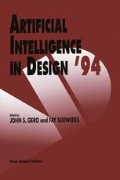Abstract
Rather than replacing a human problem solver, computers are increasingly seen as intelligent aids to problem solving. In this role the computer’s capacity for storing and rapidly retrieving large amounts of information can potentially significantly augment human problem solving. In the specific context of design problem solving, this approach has particular attractions when associated with recent advances which allow the inclusion of graphic as well as textural material. Rather than simply providing information about principles and descriptions of examples of their use to solve problems, computers could generate sets of plans, perspective drawings and even sets of pictorial representations of actual design solutions to particular types of problems. However, while this may make such systems very attractive to designers, this very richness of information may produce a significant problem for design. Design fixation involves the reproduction of both appropriate and inappropriate aspects of an example design when the example solution is shown as part of the statement of the design problem. The results of the experiment to be reported indicate that the fixation effect does not simply depend on the pictorial representation of a possible solution to a problem. Rather fixation depends on the picture embodying principles which form a part of the knowledge base of the design discipline. It is likely that the cases representing previous solutions to a problem contained in an intelligent design aid would predominantly be of this form and could therefore establish the conditions for fixation to occur. While this could in fact be beneficial where routine design is involved, it places severe constraints on innovative or creative problem solving.
Access this chapter
Tax calculation will be finalised at checkout
Purchases are for personal use only
Preview
Unable to display preview. Download preview PDF.
References
Brown, A.L.: 1989, Analogical learning and transfer: What develops? in S. Vosniadou and A. Ortony (eds), Similarity and Analogical Transfer, Cambridge University Press, Cambridge, pp. 369–412.
Gick, M. L. and Holyoak, K. J.: 1980, Analogical problem solving, Cognitive Psychology, 15, 1–38.
Jansson, D.G. and Smith, S.M.: 1991, Design fixation, Design Studies, 12(1), 3–11.
Kolodner, J.: 1985, Memory for experience, The Psychology of Learning and Motivation, 19, 2–57.
Kolodner, J.: 1991, Improving human decision making through case-based aiding, AI Magazine, 12(2), 52–68.
Purcell, A. T. and Gero, J.S.: 1991, The effects of examples on the results of a design activity, in J.S. Gero (ed.), Artificial Intelligence in Design ’91, Butterworth Heinemann, Oxford, pp. 525–542.
Purcell, A.T., Williams, P. Gero, J.S. and Colbron, B.: 1993, Fixation effects: Do they exist in design problem solving?, Environment and Planning B: Planning and Design, 20, 333–345.
Reitman, W.: 1965, Cognition and Thought, Wiley, New York.
Schank, R. and Riesbeck, C.: 1989, Inside Case-based Reasoning, Erlbaum, Hillsdale, N.J.
Simon, H.A.: 1973, The structure of ill-structured problems, Artificial Intelligence, 4, 181–201.
Author information
Authors and Affiliations
Editor information
Editors and Affiliations
Rights and permissions
Copyright information
© 1994 Springer Science+Business Media Dordrecht
About this chapter
Cite this chapter
Purcell, A.T., Gero, J.S., Edwards, H.M., Matka, E. (1994). Design Fixation and Intelligent Design AIDS. In: Gero, J.S., Sudweeks, F. (eds) Artificial Intelligence in Design ’94. Springer, Dordrecht. https://doi.org/10.1007/978-94-011-0928-4_28
Download citation
DOI: https://doi.org/10.1007/978-94-011-0928-4_28
Publisher Name: Springer, Dordrecht
Print ISBN: 978-94-010-4400-4
Online ISBN: 978-94-011-0928-4
eBook Packages: Springer Book Archive

